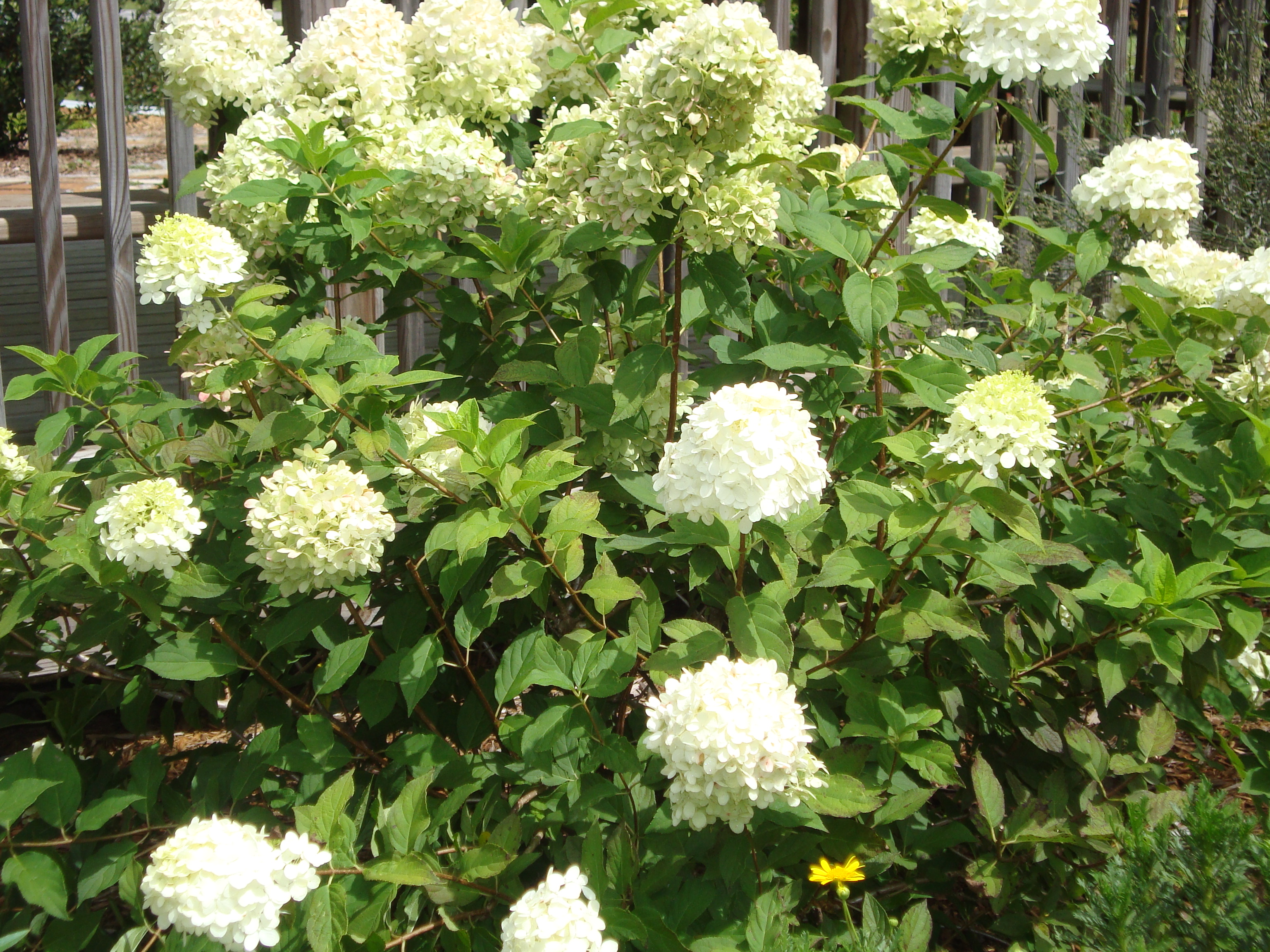
by Beth Bolles | Jun 8, 2016
Gardeners love to share plants. My yard, like many of my gardener friends, is filled with plant gifts that were started from a cutting or division of a favorite plant. These two methods of growing new plants is fairly easy once you learn the techniques and allows gardeners a way to save a little money and grow more plants for their yard, special community projects, or even some fundraising events.
In our enthusiasm over a favorite plant, gardeners must be aware that we are not allowed to propagate certain plants from cuttings or division. Many of our ornamental plants, especially newer introductions are patented plants. These are seen as ‘premium’ plants that will hopefully be in demand by the public. The plant developer or nursery invests in the patent in hopes that the plant will become the next must have ornamental. Only businesses or individuals with authorization from the patent holder are able to asexual propagate these plants since the Plant Patent Act protects these new varieties for 20 years from the date of introduction.
So if you bought a beautiful Limelight hydrangea (Hydrangea paniculata ‘Limelight’ Plant patent #12,874) for your yard, you may not take a cutting to start a new plant, even if it is only for yourself.
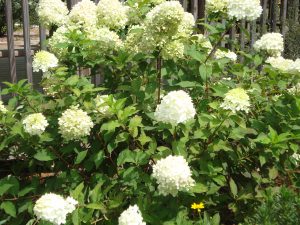
If you want more than one Limelight Hydrangea, you must purchase it. Photo by Beth Bolles
When you visit the nursery, look on the plant label which will often indicate if the plant is patented. You may also look online to see if plant has a patent.

by Ray Bodrey | Jun 1, 2016
If you’ve been researching lawn grass options recently, you’ve probably come across a not so traditional variety known as zoysiagrass. There’s no mystery why zoysiagrass has become a hit with lawn enthusiasts in the Panhandle. This variety is a great choice for coastal, warm weather climates. However, there are always management practices that need to be carefully considered, before deciding on a lawn grass variety.
Zoysiagrass was introduced to the U.S. from Asia around the early 1900’s. The grass has mostly been used for turf applications, especially on golf courses and other athletic fields. However, in recent years, breeding advances have made this variety a viable option for homeowners. Some of these improvements involve insect resistance and fast establishment periods.
Except for one species, zoysiagrasses must be planted by sod, plugs, or sprigs. Zoysia japonica is the only species commercially available in seed form. Zoysiagrass is a not a cold hardy plant. It’s the first grass variety to turn brown under cold temperatures and is slow to turn green once warmer temperatures arrive. Probably the most attractive quality of zoysiagrass is the ability to grow in virtually any soil, ranging from sandy to clay, acidic or alkaline. Moderately shaded locations are also acceptable for zoysia. Zoysiagrass is extremely drought tolerant. The plant’s root system has a great adaptation to combat drought conditions. Since the root system is very deep, it is able to maximize soil moisture potential.
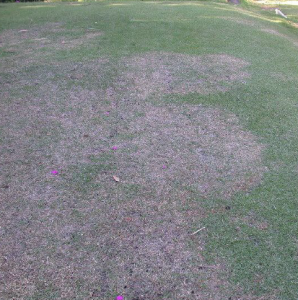
Figure 1. Large (brown) patch disease caused by Rhizoctonia solani.
Credit. J. Bryan Unruh, UF/IFAS.
Zoysiagrass is not a silver bullet for lawn problems. It encounters weed and insect problems as well. The most formidable disease of zoysiagrass is large brown patch. This disease is caused by the fungal pathogen, Rhizoctonia solani. The disease begins in small patches that turn from yellow to brown. It’s common to see these patches with healthier grass in the center. The pathogen is most active when soil temps fall between 65-75°F. This generally correlates with the fall season and then throughout the following spring in the Panhandle. Zoysiagrass is no more susceptible to the disease as any other grass, but the recovery time is lengthy. With this being said, a proactive fungicide regimen is recommended.
Zoysiagrass also responds better to smaller quantities of fertilizer applied more frequently rather than supplying larger quantities infrequently. UF/IFAS Extension recommendations state that zoysiagrass should receive three applications per year in the Panhandle region.
If you are looking to seed or sod your landscape, zoysiagrass may be an option to consider. Best management practices influence the overall health and quality of your lawn and reduces its susceptibility to disease. Take these practices into consideration when deciding on a lawn grass.
Please visit Florida Friendly Landscaping, http://fyn.ifas.ufl.edu/, for more information on maintaining your landscape.
Supporting information for this article can be found in the UF/IFAS EDIS publication “Zoysiagrass for Florida Lawns” by J. Bryan Unruh, L. E. Trenholm, and J. L. Cisar: http://edis.ifas.ufl.edu/pdffiles/LH/LH01100.pdf
An Equal Opportunity Institution. UF/IFAS Extension, University of Florida, Institute of Food and Agricultural Sciences, Nick T. Place, Dean for UF/IFAS Extension. Single copies of UF/IFAS Extension publications (excluding 4-H and youth publications) are available free to Florida residents from county UF/IFAS Extension offices.
by Carrie Stevenson | Jun 1, 2016
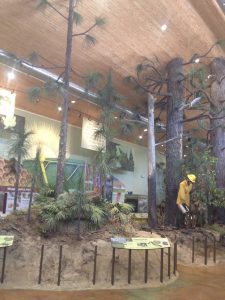
The longleaf forest display at the E.O. Wilson Biophilia Center shows typical vegetation and wildlife in the forest. Photo credit: UF IFAS Extension
Pine trees are so common in the southeastern United States that they are often taken for granted. They are usually the first to be cut down when homeowners are nervous about storms, and unless you’re in the tree-growing business, they are not considered all that valuable. However, the history and development of northwest Florida is intrinsically tied to the stately pine. During the 19th and early 20th centuries, the “naval stores” industry employed thousands of people collecting resin from pine trees. This industry produced turpentine and rosin used most famously to waterproof wooden ships, but also for soap, paint, inks, varnish, and medications.
Our area is home to seven native species, and each fulfills a specific role in the environment. In fact, during Florida Master Naturalist Program classes, we teach about pines living in all three of the broad Florida habitat types—uplands, freshwater wetlands, and coastal areas. These species can be difficult to tell apart, but a few tricks can help keep them straight.
The best way to keep track of pines is to recall that species starting with “S” (sand, shortleaf, spruce) have needles in bunches of twos (the letter S has two endpoints), and pines starting with “L” (a letter with 3 endpoints) have bunches of three (loblolly, longleaf). Finally, slash pine, starting with “SL” has bundles of 2-3 needles. Pond pine is an anomaly in that its shorter needles are in bunches of 3-5 needles.
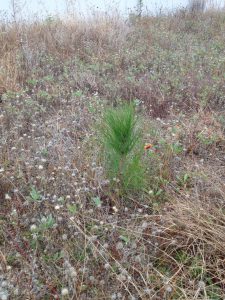
Longleaf pine sapling Photo credit: UF IFAS Extension
A few interesting facts on some of our native pine species:
- The Southeast was once covered in over 60 million acres of longleaf pine forests, the namesake of an ecological habitat that encompasses many valuable and endangered species, including bobwhite quail, red-cockaded woodpeckers, gopher tortoises, and indigo snakes. Wind resistant and adapted to frequent fires, the trees can grow 80-100 feet tall. One of the largest stands of longleaf pine in Florida is at Eglin Air Force Base.
- Pond pine often grows along the edges of wetlands and ponds. Its cones may stay closed on the tree for up to eight years, but if a fire comes through they will immediately open and release their seeds. This adaptation allows the species to take advantage of open soil in full sun after a fire to germinate new trees.
- Sand pine can grow in extremely sandy, low-nutrient soils, including beach dunes on the Gulf and Atlantic coasts. They have very short needles (2-3 inches long), and the “Choctawhatchee” variety of sand pine works well as a Christmas tree.
For detailed information on identifying all seven species along with several introduced pines, please see the new UF publication, “Common Pines of Florida.”
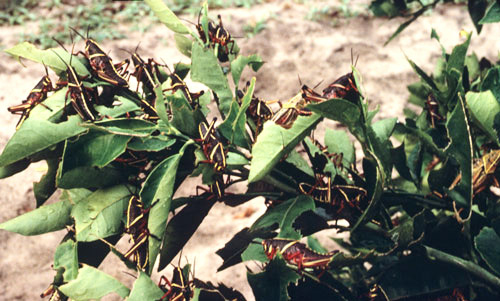
by Matthew Orwat | Jun 1, 2016
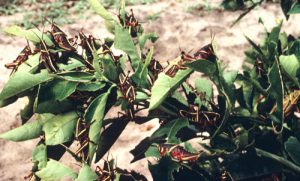
Young nymphs of the eastern lubber grasshopper, Romalea microptera (Beauvois), clustered on a citrus reset (young citrus tree). Photograph by John Capinera, University of Florida.
The Eastern Lubber Grasshopper, also known colloquially as the “Georgia Thumper,” can be highly destructive to a variety of vegetable crops. This May many growers and vegetable gardeners have reported unusually high numbers of nymphs, the juvenile form of the grasshopper.
This observation is consistent with the usual increase of nymphs in vegetable gardens during the spring months. The old adage of “an ounce of prevention is worth a pound or cure” applies here. Now is the time to exert control over the nymphs before they mature. Adults do the greatest crop damage in July and August.
Additionally, adult females lay their eggs in the summer, with hatching the following April. Reducing the numbers this year will reduce the numbers in the following years.
The first step to control of the Eastern Lubber Grasshopper is prevention. They like to feed on weedy vegetation, so reducing weed cover in and around crops will reduce the incidence of Eastern Lubber damage. Short vegetation does not usually provide enough forage for grasshoppers, so mowing vegetation around fields is an excellent preventative strategy.
Although most home gardeners can control Eastern Lubber Grasshoppers by mechanical means (hand picking) this is usually not a feasible option for large gardens or small farm plantings. Fortunately, there are several products on the market for commercial producers to use.
Keep in mind, grasshoppers are much easier to control while they are in the young nymph stage, so early action is paramount when nymphs are observed. Several effective insecticides include carbaryl, bifenthrin, cyhalothrin, permethrin, and esfenvalerate. Look at the label to find these active ingredients, since they are sold under various brand names.
For more information about the Eastern Lubber Grasshopper or for specific crop recommendations, please visit this UF/IFAS publication on Grasshoppers and the UF/IFAS Featured Creatures Entomology Page.








